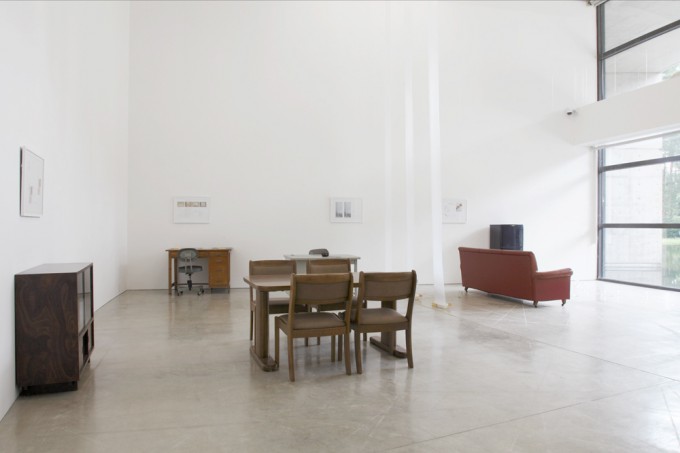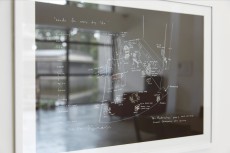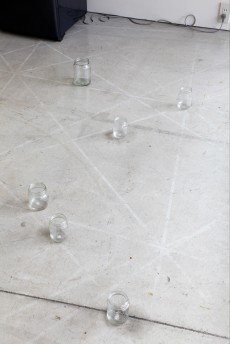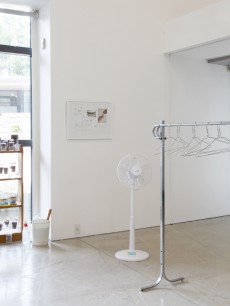
“Re-Modernologio” Phase1: Contemplationg Society Through Daily
July 23 (Sat) ~ September 19 (Mon), 2011 10:00 - 18:00 / Free
mamoru
OKUNO Mamoru

etude for everyday life Installation view
The Practice of Everyday Life for Transforming Value Structure
HATTORI Hiroyuki
The artist, mamoru, sees daily casual actions such as eating noodle, rumpling plastic wrap and making hangers as touching each other, as creative and productive activity with a positive attitude and transforms them into the experience of sounds. He finds beauty in different sounds generated naturally by daily life that we hear everyday and extracts them as a musical experience. By doing so, he produces value in things considered almost valueless.
Attitude Represented by Such Phrases as “A Few Notes” and “Etude”
On the domain name of mamoru’s official website we find the phrase “a few notesⅰ.” The word “notes” means not only “short pieces of writing” but also “signs for playing music.” In addition, he has also referred to a recent series of works as “etude.” This word usually means “study,” and also “practice piece” in musical terms. These two phrases clearly show the motivation behind his artistic activity. As we can see from his statement, “a subject that I explore deeply is familiar behavior considered unworthy of attention,ⅱ” mamoru finds value in sounds that everyone knows but is indifferent to, and in behaviors that make those sounds, for example, turning the pages of a book or getting a dish wrapped in plastic. He concentrates his attention on the sounds thought of as noise, produced like by-products from daily casual actions, and admires such sounds. What he pays attention to is familiar mundane aspects of “no significance” in our daily lives; considered unworthy or common by most people. Through his work, including performances and workshops, he transforms such insignificance into entities containing universal value and attempts to share them with others. He trains himself in various ways in order to live his daily life exquisitely. The words “etude” and “a few notes” may represent his attitude that he should live his life with the purpose of getting awakened to many things, i.e. interpreting everyday behaviors as creative actions and not just passing through time as just a consumer.
Admiration and Space for Dialogue
His sense of value can be seen clearly in the case of the Japanese tea ceremony, as he remarks. The relationship between him and his viewers resembles the relationship between hosts and guests during this tea ceremony. In the tea room the host uses his or her refined tastes to please the guests and arranges everything for the ceremony; i.e. selecting tea bowls, metal pots and all the tools depending on the situation on any given day. He or she takes down the hanging scrolls and puts flower arrangements one by one very carefully in the alcoves. The guests read closely about the delicacy on offer and the thoughts behind their arrangements, holding a dialogue with each other and both host and guests admire the arrangement together. In mamoru’s work he continues to explore musical improvisation. He chooses his programs flexibly depending on the location and the nature of his audience on a given day, and composes his performance through a dialogue with his viewers. His soundscapes are attained by the interaction between him and his viewers. Following his guidelines or at times working against them, the viewers discover and read closely something interesting about the ordinary items of daily life and the sounds produced by such things and as they have been carefully presented to them by the artist.
Normally, sounds play an important role in narrating the structure of the tea ceremony: the last guest closes the door with a sharp sound to alert the host that all guests are present in the room; these guests shuffle forward on the tatami, a Japanese traditional mat, with smooth sounds and then they drink the bowl of tea with an audible sound. The host becomes aware the passing stages of the ceremony by listening to these sounds and, for example, can tell the temperature of the hot water and can discern when to make tea by listening to the changing sound of the boiling water in the metal pot. Each sound has meaning and the tea ceremony is made up of a sequence of such minimal elements. The sense of minimalism is also seen in mamoru’s work, for example, a series of etudes in which he creates a soundscape from the minimal human actions found in our daily lives. Each behavior has a clear and causal relationship with the other.
Musical Technique – Sampling and Remixing
Next, let us focus on the elements of his work that consist of sampling and remixing, which he calls the technique of “graftingⅲ.” Based on the belief that human beings do not need new products any more since our society is already replete with them, he thinks that it is possible to shake people’s faith or impress them by finding some new value in already existing things, adding something to them, thus transforming the object, be it dramatically or modestly. He studied jazz piano at first but abandoned it because of heath problems, but then later began to explore improvisational music. His improvisation evolved by degrees until he came to his present style of work in which he uses sounds from the surrounding environment and daily commodities in an attempt to involve the viewers as they listen to these sounds.
In his work, “etude no.7 straw”, he discovered the unexpected and appealing sounds of blowing a straw and he recorded the sound and then sampled it to create the composition. He did not fully appreciate the huge variety of sounds available all around him until he became unable to play the piano. Since then he has listened intently to those sounds. Although a straw usually ends up as trash after being used, mamoru transformed it into a musical instrument by blowing it, giving it a totally different function. There is something peaceful in the funny scene where the participants strain to blow straws as they surround mamoru, and the atmosphere shared by them is pleasant. Moreover, the mundane straw can be transformed into something special after each person takes it home. The straw is given a new context and new value through his positive re-interpretation.
In another work “etude no.39 instant noodle”, he spices up a series of actions from cooking instant noodles to eating them, thereby transforming the consumer activity of eating into a kind of creative and productive activity of playing a tune. This artwork takes shape in both his own performance and in the installation that the viewers experience. By putting dried noodles, which no one considers beautiful, in a transparent container, he transforms them into something that attracts people’s attention, giving a special quality to the whole process of preparing the meal from the pouring of hot water to the serving of the food. Even in the process of cooking the noodles, he sets the scene so that everyone can exercise some creative control in choosing and cooking the many ingredients such as green herbs, white bean sprouts and yellow, crunchy bits of deep fried dough for the topping as well as pepper, soy sauce and Chinese red chili oil for the seasoning. In this way, he transforms the normally mundane actions of cooking and eating instant noodles into the viewers’ own special experience. They boil water, cook merrily, pour hot water and listen to the sounds of these actions with their ears more alert. The best time to eat is when the noodles have just stopped making the sounds they do while absorbing the hot water. The viewers also listen to the sounds produced from sucking in the noodles. These actions are rarely given any attention or thought but by adding a bit of playfulness we can make the experience a musical one, worthy of a very close listening.
Space Created by Interaction Between Performance and Appreciation
For the exhibition at Aomori Contemporary Art Centre, he obtained or borrowed a dining table, desk, cupboard, sofa, refrigerator, electric fan and other household goods, such as hangers, from several homes and arranged them carefully in a unique gallery space, 6 meters high with a large windowpane. To this he added nine framed drawings on the wall It seems that these pieces of furniture, electrical appliances and the drawings are the only subjects of the installation in the white cube gallery setting, made up to look like a normal interior. But that’s not all. This is also a space for experiencing performance and appreciation at the same time, which is created using a unique musical approach. The viewers can create sounds with their hands and listen to the sounds here. In this space, drawings on the wall can be interpreted as scores telling us how to play the music and the electric fan, hangers, ice cubes in the refrigerator or glasses as instruments producing sounds. And then the viewers visiting the space can be interpreted not only as performers using such scores and instruments to play the music, but also as an audience listening to the music. Following the instructions of the score, they take an ice cube with a string from the refrigerator, suspend it from a hook in front of the window, the ice cube melts bit by bit and the drops of water fall down into a glass, making very beautiful sounds. They listen to these sounds while sitting leisurely on the sofa at the rear of the space and at the same time they turn on the electric fan, which is set in front of the side hanger rack, and then listen to the sounds from the hangers as they are blown by the breeze of the fan and hit each other. mamoru had only worked with one sound at a time, but for this installation he created the so-called hybrid space where viewers can experience several different sounds at once like an ensemble. It is piquant that the passive act of listening cannot be attained without the active and productive act of performing, that is, there exists an interchange between both roles.
Living the Present Time
Through his activities, mamoru essentially intends to make everyday life flourish more by “listening” or “bending your ears.” Although our ears are always exposed to the outside world and hear different sounds, it is common to pay no attention to most of them. He listens to such sounds as carefully as possible, makes a choice among them and finds something interesting in these sounds that are considered unworthy by most people. Then he interprets and re-constructs the sounds with a positive attitude to form them into a musical piece that he names etude.
He says that he wants to speak with those who live in our contemporary worldⅳ. He seems to be trying to find a way to survive the world before his eyes, making it more beautiful and rich by sharing daily moments of awareness and wonder with others through his work. If we can understand his attitude of “admiring the sounds of our daily lives,” and of being sensitive to the minutiae of everyday life, we can also discover our own subject to “admire,” so that we can find our own way to survive the world more merrily while sharing this way with others. In the internet society, we’ve already had very active intercommunication between production and consumption. The act of consuming is sometimes converted or interpreted into an activity that actually produces, creating a fuzzy line between the two. In our physical world, his creative technique for making the most of existing products, that is, to convert consumption activity into a kind of alternative production activity and not just sticking to a consumption activity, may give us suggestive hope for shaping a new kind of attitude towards living everyday life.
References
ⅰOfficial website of mamoru: http://www.afewnotes.com/
ⅱmamoru. (2011). etude for everyday life. YUKA CONTEMPORARY.
ⅲInterview with mamoru in AC2 vol.13.
ⅳInterview with mamoru in AC2 vol.13.

etude for everyday life Installation view

Concept drawing

etude no.13 ice

etude no.13 ice

etude no.13 ice

etude no.36 water and dry earth

etude no.36 water and dry earth

etude no.11 steel hanger

etude no.18 plastic bag
「再考現学 / Re-Modernologio」 phase1 : 衣食住から社会をまなざす
2011年7月23日(土)~ 9月19日(月)10:00 - 18:00/無料
mamoru
OKUNO Mamoru

《etude for everyday life / 日常のための練習曲》全景
価値構造を転換する日常的実践
服部浩之
ラーメンを食べる、ラップをクシャクシャにする、ハンガーを触れ合わせる、そんな何気ない日常における所作を、積極的に 創造的な生産活動として誤読することで、音の経験へと変換するのがmamoruというアーティストだ。mamoruは日々私たちが耳にしている生活のなかで不可避的に生じる音に美を見出し、それを音楽的体験として抽出することで、ほとんど無価値だと思われているものに価値を与えていく。
a few notesとetudeという態度表明
mamoruのウェブサイト・ドメインには"a few notes"[i]ということばが採用されている。このことばは直訳すると、「いくつかのメモ」となるが、noteには「音符」という意味もある。そして彼の近年の作品群のタイトルである"etude"ということばは、「練習」を意味し、音楽用語では「練習曲」を示す。これらのことばを手がかりにすると、mamoruの活動のモチベーションがよく見えてくる。「ありふれて気にもとめないような行為を習熟の対象としてしまう。」[ii]と言うように、mamoruが価値を見出すのは、誰もが知っているけれどほとんど素通りするような音と、それを発生させる所作にある。本のページをめくる音や皿にラップをする音など、日々の何気ない動作のなかで副産物的に発せられるノイズとされる音に着目し、その音を愛でるのだ。mamoruは人が「無価値」だとか「どうでもいい」と思っている日常にあふれる存在の「どうでもよさ」に着目しており、パフォーマンスやワークショップなども内包した作品を介して、そのどうでもよさを普遍的な価値に転換し、他者と共有することを試み、日常生活を優美に生きるための様々な修練をしているのだ。”etude”や”a few notes”ということばは、日々の生活を単なる消費行為として受動的に過ごすのではなく、それを能動的に創造行為に読み替えられるよう、意識的に気付き の多い日々を過ごそうという生活態度を表明するものであると思う。
愛でることと対話的空間
mamoruのこの価値観は彼も言及している茶の湯を例に挙げるとよく見えてくる。彼と鑑賞者の関係は、茶の湯における亭主と客の関係に近い。茶の席で は、亭主は客を最大限もてなすように趣向を凝らし、その日の状況に応じて、茶碗や茶釜を選び、道具を精選し、そして床の間に飾る軸や生ける花などを、ひとつひとつ細やかな気配りにより吟味し配置して茶の席を設える。客は亭主の心遣いとその背後にある意図を丁寧に読み込み、対話し、それを主客が共に愛でるのだ。即興演奏を続けてきたmamoruは、常にその日の会場や観客に応じてパフォーマンスの流れを柔軟に変化させ、相手との対話を重視するかたちで演奏を 組み立ててきた。mamoruがつくる音の空間は、主人である彼が用意した日常の品々とその音を、彼の誘導に従い、あるいはそれを裏切るように、客が自ら面白みを発見し読み込むという応答関係により成立するのだ。
また、茶の湯では音で場面の進行の多くが判断される。客人は、末尾の場合は茶室に全員が入ったことを知らせるためににじり口の戸をピシっと閉めたり、畳の上をスッスッと摺り足で敢えて音をたてて移動したり、いただいたお茶をズーッと飲み干したりする。また亭主はそれらの音で場面の展開を判断し、釜の湯の沸く音の変化で湯温や茶の立て時を知る。ひとつひとつの音には全て意味があり、それら最小限の要素の連鎖で全体が構成される茶の湯のミニマルさは、そのままmamoruのetude作品における最小限の行 為を切り取り再構成される音空間にも見出すことができる。全ての所作には明解な因果関係があるのだ。
音楽的手法~サンプリングとリミックス
次にmamoruが「接ぎ木」[iii]的手法と表現する、サンプリングやリミックスにより形成される作品構造に言及したい。彼は、ものに溢れた今の社会においてこれ以上新しいものは必要ないという思想をベースに、既にある物事のどこかに新たな意味を見出し、そこに何かしらを加味することで、劇的な、あるいはささやかな変化を生じさせ、人の思考を揺るがしたり感動を与えたりできると考えている。mamoruは元々ジャズピアノを学んでいたが身体を壊しピアノが弾けなくなり、しばらくのちに即興演奏 をはじめる。そして即興が徐々に変化していき、現在の観客と能動的に関わるよう彼をとりまく環境や日用品を用いて音を発する/聴く作品へと至った。
《etude no.7 プラスチックストロー》は、ストローを吹いてみたら意外といい音がすることに気付き、録音してサンプリングし即興演奏に用いるという過程を経て生み出されたものだ。ピアノ演奏が出来なくなってはじめて眼前に広がる音の多様さを発見し、その音に聴き入るようになった。ストローは飲み物を飲み干したらゴミとして捨てられてしまうが、そのストローを「吹く」ことで楽器に変換し、まったく別の機能を与えた。また、mamoruを中心に皆がストローを 一生懸命吹いている様子の滑稽さは和やかで、共有される場の空気も心地よいのだ。なんでもないストローは各人に持ち帰られることで、特別な存在に転換される。ストローはmamoruのポジティブな読み替えと接続により文脈化され、価値を与えられるのだ。
また 《etude no.39 インスタントヌードル》は、インスタントラーメンをつくって食べるまでの行為に気の利いた小さなアレンジを加えることで、食事という消費活 動を、音を奏でるというある種の創造的生産活動に変換するものだ。これは彼自身のパフォーマンスとして披露するだけでなく、観客が体験できるインスタレー ションとしても成立させている。美しいと認識されることなどない固形のインスタント麺を敢えて透明の容器にいれることで、それを着目すべき存在に換え、お湯が注がれてラーメンができるまでを特別な時間にする。ラーメンをつくる過程においても、トッピングに緑の香草や白いもやしや黄色の天かすなどを、調味料に胡椒に醤油やラー油などを多数用意することで、各人がそれぞれ能動的に選択して調理するという小さな創造性を発揮する場面を挿入し、インスタント麺をつくって食べるという行為をひとりひとり独自の特別な体験に転換してしまうのだ。湯を沸かし、たのしく調理し、湯を注ぎ、そっと耳に近づけ音を聴く。麺が湯 を吸う音が止んだ頃にはちょうど食べ時で、今度はそれをすすって食べる音をまた聴く。ほんとうになんでもない行為だけれど、そこにささやかな遊び心とスパイスを加えるだけで、その音を耳をかたむけて聴く価値のある音楽体験にしてしまうのだ。
演奏/鑑賞の相互作用により成立する空間
ACACでは、天井高6mで大きなガラス面をもつ非日常のギャラリー空間に、いくつかの家庭から貰い受けたり借りてきたりして入手したダイニングテーブ ル、事務机、茶棚、ソファ、冷蔵庫、扇風機にハンガーラックなどの生活用品を丁寧に配置し、その壁面には額装されたドローイング計9点を掛けた。 ホワイトキューブに設えられた日常生活のため家具・家電や壁に掛けられた絵画が鑑賞すべき作品のようにも見えるが、それだけではない。これは観客が自身の手で音を奏で耳を澄ますために、極めて音楽的な作法で生成された演奏と鑑賞を同時に経験する空間なのだ。壁にかけられた絵画は音を奏でる方 法を示す楽譜(スコア)であり、扇風機やハンガー、冷蔵庫の中の氷やガラス瓶は音を発する楽器である。そして、その空間を訪れる観客は、そ れらの楽譜と楽器を用いて自ら音を奏でる演奏者であり、同時にその音を聴く聴衆でもある。楽譜の指示に従い冷凍庫から紐が付けられた氷を取り出し、それを窓の前にあるフックにかけると、徐々に氷が溶けていき、水滴がその下に置かれたガラス瓶に落ちて美しい音を発する。それを後ろのソファにゆったり座って聞く。また同時に脇にあるハンガーラックの前に設置された扇風機のスイッチをオンにすると、扇風機の風がハンガーを揺らし触れ合う音が聴こえてくるという具合だ。ひとつだけの音の体験を抽出するのではなくmamoruが発見してきた様々な日々の音をアンサンブルのように同時に奏で体験できるハイブリッドな空間に仕上げた。鑑賞という受動的な行為が、演奏という能動的で生産的な行為を経ないと成立しない転倒感も小気味よいのだ。
今を生きること
mamoruの活動の根底には「聴く」ことや「耳をかたむける」ことによって、日々の生活をより豊かなものにしようという意思がある。私たちの耳はつねに 外界にさらされ様々な音を拾うが、多くは無意識のうちに聞き流してしまっている。mamoruは耳に入る音をなるべく丁寧に聴きとり、その中から取捨選択して他の人にはあまり価値を感じられない音にも面白みを見出し、それをポジティブに誤読し再構築することでetudeという音楽作品に昇華する。
「自分は、今生きている人と話がしたい[iv]」 とmamoruは言う。彼は作品化を通じて他者と日々の発見や驚きを共有することで、眼の前にある世界をより美しく豊かに生き抜く方法を模索しているのかもしれない。「日々に溢れる音を愛でる」という彼の態度を理解し、まずは日常生活の細部にまで意識を巡らせてみることで、私たちも自分なりの「愛でる」対 象を発見できれば、それを共有する対話を通じて、世界をより愉快にサバイブするそれぞれの手法を見出すことができるだろう。ネット上の世界では既に生産・ 消費の相互交通が非常に活発で、消費活動が生産活動に転換されたり読み替えられることは多々あり、その境界は極めて曖昧だ。現実世界において、既に存在するものを使用する技術、つまり消費を単純な消費に終わらせるのではなくオルタナティブな生産行為に変換する彼の創造的技術は、日々を生きる基本的態度とし ても私たちにとって非常に示唆に富んだものではなかろうか。
[i] mamoruウェブサイト参照http://www.afewnotes.com/
[ii] mamoru、『日常のための練習曲』、YUKA CONTEMPORARY、2011年
[iii] AC2 13号 mamoruインタビュー参照
[iv] AC2 13号 mamoruインタビュー参照

《etude for everyday life / 日常のための練習曲》

コンセプトドローイング

《etude no.13 氷》

《etude no.13 氷》

《etude no.13 氷》

《etude no.36 乾いた土に水を》

《etude no.36 乾いた土に水を》

《etude no.11 スチールハンガー》

《etude no.18 ポリ袋》
